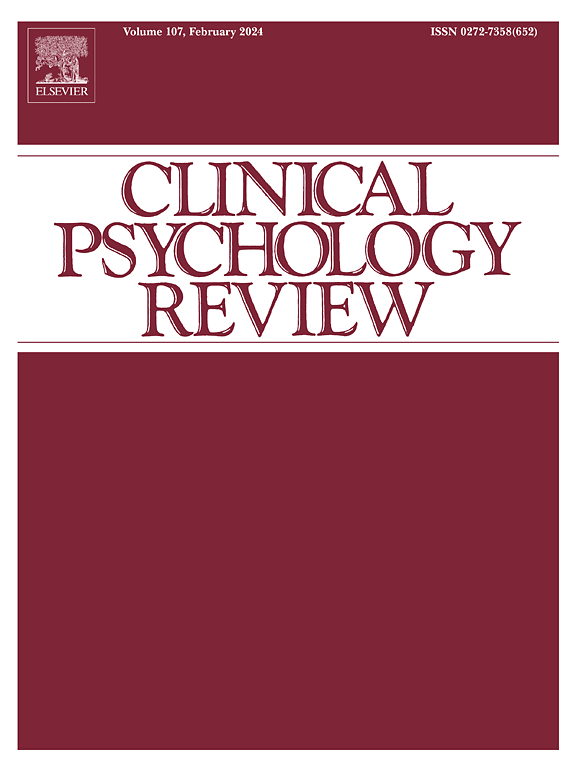视角的桥梁--53 种妄想症理论模型的回顾与综述。
IF 12.2
1区 心理学
Q1 PSYCHOLOGY, CLINICAL
引用次数: 0
摘要
现有的众多妄想形成模型在多大程度上存在分歧或提出了共同的机制,目前仍不清楚。为了全面了解妄想的病因,我们总结了从系统文献检索中提取的 53 种妄想理论模型。我们确定了五种核心观点的中心内容和独特或总体特征:认知(22 个)、联想学习(4 个)、社会(6 个)、神经生物学(6 个)和贝叶斯推理(15 个)。这些观点的重点和机理解释各不相同。一些人认为妄想是联想和操作性学习的结果,而另一些人则认为是先前的信念和感觉输入的整合失衡,或强调信息处理偏差的相关性。推测的调节因素包括适应不良的泛化信念、神经认知障碍、多巴胺、压力和情感失调。这些模型在试图解释妄想形成的一般情况还是妄想内容(即迫害性妄想)方面也有所不同。最后,一些模型假设了妄想的功能方面,如洞察力缓解。尽管存在差异,但这些观点的共同点是,妄想的形成是对经验模糊性的一种解释。在这一共同点的基础上,我们提出了一个综合框架,其中包含了每种观点的基本机理解释,并讨论了其对研究和临床实践的影响。本文章由计算机程序翻译,如有差异,请以英文原文为准。
Bridging perspectives - A review and synthesis of 53 theoretical models of delusions
The degree to which numerous existing models of delusion formation disagree or propose common mechanisms remains unclear. To achieve a comprehensive understanding of delusion aetiology, we summarised 53 theoretical models of delusions extracted from a systematic literature search. We identified central aspects and unique or overarching features of five core perspectives: cognitive (n = 22), associative learning (n = 4), social (n = 6), neurobiological (n = 6), and Bayesian inference (n = 15). These perspectives differ in foci and mechanistic explanations. Whereas some postulate delusions to result from associative and operant learning, others assume a disbalance in the integration of prior beliefs and sensory input or emphasise the relevance of information processing biases. Postulated moderators range from maladaptive generalised beliefs over neurocognitive impairment to dopamine, stress, and affective dysregulation. The models also differ in whether they attempt to explain delusion formation in general or the delusional content (i.e., persecutory). Finally, some models postulate functional aspects of delusions, such as insight relief. Despite their differences, the perspectives converge on the idea that delusions form as an explanation for an experienced ambiguity. Building on this common ground, we propose an integrative framework incorporating essential mechanistic explanations from each perspective and discuss its implications for research and clinical practice.
求助全文
通过发布文献求助,成功后即可免费获取论文全文。
去求助
来源期刊

Clinical Psychology Review
PSYCHOLOGY, CLINICAL-
CiteScore
23.10
自引率
1.60%
发文量
65
期刊介绍:
Clinical Psychology Review serves as a platform for substantial reviews addressing pertinent topics in clinical psychology. Encompassing a spectrum of issues, from psychopathology to behavior therapy, cognition to cognitive therapies, behavioral medicine to community mental health, assessment, and child development, the journal seeks cutting-edge papers that significantly contribute to advancing the science and/or practice of clinical psychology.
While maintaining a primary focus on topics directly related to clinical psychology, the journal occasionally features reviews on psychophysiology, learning therapy, experimental psychopathology, and social psychology, provided they demonstrate a clear connection to research or practice in clinical psychology. Integrative literature reviews and summaries of innovative ongoing clinical research programs find a place within its pages. However, reports on individual research studies and theoretical treatises or clinical guides lacking an empirical base are deemed inappropriate for publication.
 求助内容:
求助内容: 应助结果提醒方式:
应助结果提醒方式:


